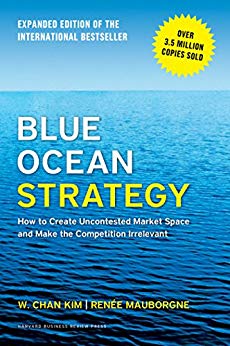

This article is an excerpt from the Shortform summary of "Blue Ocean Strategy" by W. Chan Kim and Renee Mauborgne. Shortform has the world's best summaries of books you should be reading.
Like this article? Sign up for a free trial here .
Blue Ocean Strategy is a powerful framework for finding new business opportunities. But it’s not always clear how to create a blue ocean strategy for yourself. We’ll cover 15+ Blue Ocean Strategy examples so you can figure out how to create your own blue ocean.
Quick Review of Blue Ocean Strategy
Before we dive into Blue Ocean Strategy examples, let’s get clear on what a blue ocean is. Consider two types of oceans:
- Red oceans, where competition is fierce in bloody waters, strategy centers around beating rivals, and wins are often zero-sum.
- Blue oceans, where a market space is new and uncontested, and strategy centers around value innovation.
Blue ocean strategy pushes companies to create new industries and break away from the competition.
In short, you create a blue ocean by focusing on the factors that customers really care about, while discarding factors they don’t. This creates a new product offering that doesn’t currently exist. Because it doesn’t exist, you don’t have competitors competing directly against you. Furthermore, you attract a new type of customer the industry hadn’t previously supported, thus growing the market.
To illustrate how Blue Ocean Strategy can be used in a variety of industries, we’ll cover three very different industries – automobiles, computers, and movie theaters.
Blue Ocean Strategy Example 1: Automobile Industry
- In the 1890s, the horse and buggy was the primary mode of transportation.
- In 1893, the Duryea brothers created the first automobile. Despite being unreliable, they cost $1,500, twice the average annual income. They thus became a publicly maligned symbol of excess.
- In 1908, 500 American automakers existed making custom automobiles. Henry Ford created the Model T, the first standardized, mass-produced automobile. This was a Blue Ocean Strategy example.
- Standardization reduced costs by employing unskilled laborers instead of car artisans. Limiting car options reduced the number of unique parts needed.
- It cost $850, half the price of existing cars. By 1924 the price was down to $290.
- By 1923, the majority of American households owned an automobile.
- Market share increased from 9% in 1908 to 61% in 1921
- Now that cars were mass-market, Ford’s cars were getting boring. In 1924, General Motors introduced variety – “a car for every purse and purpose.” This was a Blue Ocean Strategy example.
- A range of options created new demand as buyers went up or down-market relative to the Model T.
- With frequent updates to cars, they were replaced more frequently, driving up demand.
- From 1926 to 1950, GM increased market share from 20% to 50%, while Ford’s fell from 50% to 20%.
- But Ford and Chrysler followed this strategy, and they began a red ocean period of competition and imitation. The Big 3 owned 90% of the US market.
- In the 1970s, Japanese manufacturers created a blue ocean of small, efficient, high-quality cars. US automakers, who had fallen complacent and focused on luxury, were caught by surprise.
- In 1984, Chrysler unveiled the minivan, a cross between a car and a van. It became Chrysler’s bestselling car.
- In the 1990s, the SUV was introduced, featuring increased space over the minivan and rugged four-wheel drive and towing capabilities.
Blue Ocean Strategy Example 2: Movie Theater Industry
- Before movies, a major form of visual entertainment was through live theater or operas. This catered primarily to the educated upper class, out of reach of working-class people. They played only a few times a week and were located in wealthy neighborhoods.
- In 1893, Thomas Edison invented the Kinetoscope, allowing a peepshow a few minutes long. These were used as interludes for live theater.
- In 1905, the blue ocean of movie theaters was created by Harry Davis with the nickelodeon. Simple theaters were constructed in lower-rent neighborhoods. Shows cost only 5 cents and played from morning to night. The content was fun and accessible.
- By 1914, the US had 18,000 nickelodeons with 7 million daily admissions.
- Nickelodeons were widespread, but were considered low-brow. In 1914 Palace Theaters created a blue ocean by moving upmarket, creating plush theaters showing longer films with more mature plots. This attracted upper/middle-class theater-goers at a reduced price. This was a Blue Ocean Strategy example.
- Eventually, Americans moved into suburbs, and Palace Theaters were too expensive to service a large geographical area.
- Competition pushed theaters to be small, running a movie per week. It didn’t feel like a special night out any longer.
- In 1963, AMC introduced the multiplex, with multiple different-sized theaters showing a variety of films. This helped meet a wider array of buyer needs while spreading risk and lowering costs. This was another Blue Ocean Strategy example.
- In a similar move, in 1995 AMC created the 24-screen megaplex. This combated the trend of moviegoers watching movies at home on VHS instead by offering superior sight and sound.
- The larger scale also gave it operational economies and leverage with distributors.
- Further blue ocean moves include online streaming of movies like Netflix.
Blue Ocean Strategy Example 3: Computer Industry
- Before computers, businesses ran operations with a ledger and a pen. This was low-cost but relatively slow.
- In 1890, Herman Hollerith invented the punch card tabulating machine for census calculations. It was expensive and difficult to use and required maintenance. The business was merged to form CTR in 1911.
- In 1914, Thomas Watson at CTR simplified tabulators. This reduced cost and training time.
- Furthermore, he created a new leasing model where businesses could avoid large upfront costs and upgrade machines frequently.
- By 1924, CTR held 85% of the tabulating market and became IBM.
- In 1952, the first electronic computer, named the UNIVAC, was released by a competitor. Despite few sales, IBM recognized the promise and released the IBM 650, a less powerful but less complicated computer. This was a Blue Ocean Strategy example.
- By the end of the 1950s, IBM had captured 85% of the business electronic computer market.
- IBM then introduced the System/360, a range of computers from small to large needs. It introduced interoperable software and equipment.
- IBM also unbundled hardware, services, and software, selling individually and creating the new software and services industries.
- In the 1970s, IBM, DEC, and others competed on building more powerful machines for the business market. Then in 1978, Apple created the first popular home computer – the Apple II.
- The Apple II wasn’t the first personal computer – the Altair 8800 was. But the latter was difficult to use, with no monitor, no permanent memory, no keyboard. This led president of DEC to say “there’s no reason for any individual to have a computer in their own home.”
- The Apple II combined existing technology into an easy-to-use solution with compelling software for the home (like word processors and games). At a low enough price, computers went mainstream. This was a Blue Ocean Strategy example.
- IBM followed suit and offered their own PCs in 1982.
- In the mid-1990s, computer manufacturers competed on performance, offering more features and software, and sold through distributors. Dell Computer upended this pattern, selling direct to consumers and reducing price substantially.
- Dell reduced delivery time to 4 days, compared to the industry average of 10 weeks.
- Further blue oceans include the tablet with Apple’s iPad, cloud computing services, and mobile phones.
Blue Ocean Strategy Example 4: Cirque du Soleil
A former street performer, Guy Laliberté decided to escape the red ocean of circuses to create a blue ocean of theatrical entertainment: Cirque du Soleil. Its shows combine the circus with adult theater, showing incredible acrobatics and physical feats set to a storyline and original music.
Learn about Cirque du Soleil’s blue ocean strategy here.
Blue Ocean Strategy Example 5: Yellow Tail Wines
Even though 1,000+ premium wineries tried to differentiate from each other, they were strategically very similar. To customers, they were largely all different from box wines in the same way.
The Australian firm Casella Wines examined the wine industry from a different perspective: how do you make wine that’s easy to drink and fun? Wine alternatives like beer and spirits accounted for the majority of sales, so clearly most Americans saw wine as a turn off. It was intimidating and pretentious.
Learn more about yellow tail wine’s blue ocean strategy here.
Blue Ocean Strategy Example 6: Consider Different Buyers in the Chain
Companies often target the person with purchasing power, who may sometimes be a different person with different preferences from the actual user. For instance, a corporate software vendor often caters to the CTO (who cares about cost reduction) rather than the engineers who will use the product (who care about ease of use).
Consider targeting the end-user’s pain points, especially if they’ve traditionally been ignored, and creating a new product with a different value curve.
Blue Ocean Strategy Examples
- Pharma concentrates primarily on influencing doctors, the decision-makers who write prescriptions. Diabetics needing insulin had to deal with vials, syringes, and needles several times a day.
- Novo Nordisk, which made its name manufacturing insulin, addressed the user pain point with the NovoPen, a pen-sized device with an insulin cartridge that allowed easy injection. This revolutionized insulin treatment and became the dominant form of insulin administration.
- In the financial information industry, Reuters and Telerate dominated by appealing to IT managers, who favored standardization.
- Bloomberg focused instead on traders, who wanted ease-of-use and more powerful features like keyboard shortcuts, multiple monitors, and analytical tools to help them assess fair market value. They also introduced features around the users’ personal lives, like the ability to buy flowers and make travel arrangements through the terminal.
- (Shortform example: Corporate software-as-a-service (SaaS) products traditionally target the buyer in corporations, like the Chief Information Officer or senior management. A new strategy is to get a mass of end users onboard, who then influence upward and ask their bosses to pay for the product. Slack and Dropbox are examples.)
Key questions: Who are the buyers in your industry? Have any buyers traditionally been ignored? Can you create a new product targeting their pain points?
Blue Ocean Strategy Example 7: Look at Your Product’s Complements
Products are rarely used in isolation – they’re part of the total experience. Going to the movies also requires finding a babysitter, parking, and possibly a drink afterward.
Consider what happens before, during, and after your product is used. Offering complements to your product – even at cost – may add additional value through bundling.
Blue Ocean Strategy examples…
———End of Preview———

Like what you just read? Read the rest of the world's best summary of "Blue Ocean Strategy" at Shortform . Learn the book's critical concepts in 20 minutes or less .
Here's what you'll find in our full Blue Ocean Strategy summary :
- What blue oceans are, and how you create one for your business
- Why some businesses succeed in creating blue oceans, and why others fail
- The red ocean traps you have to avoid if you want business growth






